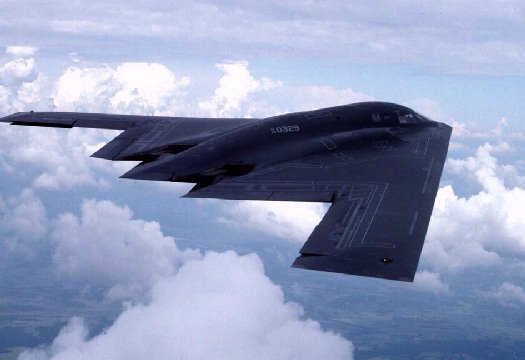B2 Bomber

USAF Photo by MSgt. Rose Reynolds
Mission
The B-2 Spirit is a multi-role bomber capable of delivering both conventional
and nuclear munitions. A dramatic leap forward in technology, the bomber
represents a major milestone in the U.S. bomber modernization program. The
B-2 brings massive firepower to bear, in a short time, anywhere on the globe
through previously impenetrable defenses.
Features
Along with the B-52 and B-1B, the B-2 provides the penetrating flexibility
and effectiveness inherent in manned bombers. Its low-observable, or "stealth,"
characteristics give it the unique ability to penetrate an enemy's most
sophisticated defenses and threaten its most-valued, and heavily defended,
targets. Its capability to penetrate air defenses and threaten effective
retaliation provide a strong, effective deterrent and combat force well into
the 21st century.
The revolutionary blending of low-observable technologies with high aerodynamic
efficiency and large payload gives the B-2 important advantages over existing
bombers. Its low-observability provides it greater freedom of action at high
altitudes, thus increasing its range and a better field of view for the
aircraft's sensors. Its unrefueled range is approximately 6,000 nautical
miles (9,600 kilometers). The B-2's low observability is derived from a
combination of reduced infrared, acoustic, electromagnetic, visual and radar
signatures. These signatures make it difficult for the sophisticated defensive
systems to detect, track and engage the B-2. Many aspects of the
low-observability process remain classified; however, the B-2's composite
materials, special coatings and flying-wing design all contribute to its
"stealthiness."
The B-2 has a crew of two pilots, an aircraft commander in the left seat
and mission commander in the right, compared to the B-1B's crew of four and
the B-52's crew of five.
Background
The first B-2 was publicly displayed on Nov. 22, 1988, when it was rolled
out of its hangar at Air Force Plant 42, Palmdale, Calif. Its first flight
was July 17, 1989. The B-2 Combined Test Force, Air Force Flight Test Center,
Edwards AFB, Calif., is responsible for flight testing the Engineering,
Manufacturing, and Development aircraft as they are produced. Five of the
six developmental aircraft delivered to Edwards are still involved in continuing
flight testing. The first test aircraft is currently kept in flyable storage.
Whiteman AFB, Mo., is the B-2's only operational base. The first aircraft,
Spirit of Missouri, was delivered Dec. 17, 1993. Primary maintenance
responsibility for the B-2 is divided between Oklahoma City Air Logistics
Center at Tinker AFB, Okla. for avionics software (contractor); Ogden Air
Logistics Center, Hill AFB, Utah for landing gear and trainers (contractor);
and the Northrop-Grumman facility at Air Force Plant 42 at Palmdale for periodic
depot maintenance.
The prime contractor, responsible for overall system design and integration,
is Northrop Grumman's B-2 Division. Boeing Military Airplanes Co., Vought
Aircraft Co., Hughes Radar Systems Group and General Electric Aircraft Engine
Group are key members of the aircraft contractor team. Another major contractor,
responsible for aircrew training devices (weapon system trainer and mission
trainer) is Hughes Training Inc. (HTI) - Link Division, formerly known as
C.A.E. - Link Flight Simulation Corp. Northrop-Grumman and its major
subcontractor HTI, excluding Link Division, is responsible for developing
and integrating all aircrew and maintenance training programs.
General Characteristics
Primary function: Multi-role heavy bomber.
Prime Contractor: Northrop B-2 Division.
Contractor Team: Boeing Military Airplanes Co., Vought Aircraft Co., and
General Electric Aircraft Engine Group and Hughes Training Inc. -- Link Division
Power Plant/Manufacturer: Four General Electric F-118-GE-100 engines
Thrust: 17,300 pounds each engine
Length: 69 feet (20.9 meters)
Height: 17 feet (5.1 meters)
Wingspan: 172 feet (52.12 meters)
Speed: High subsonic
Ceiling: 50,000 feet (15,152 meters)
Takeoff Weight (Typical): 336,500 pounds (152,635 kilograms)
Range: Intercontinental, unrefueled
Armament: Nuclear or conventional weapons
Payload: 40,000 pounds (18,144 kilograms)
Crew: Two pilots, with provisions for a third crew station
Unit cost: Approximately $1.3 billion
Date Deployed: December 1993
Air Force Inventory: Active force: 20 planned (operational aircraft); ANG:
0; Reserve:0
This information came
from
U.S.A.F Fact
Sheet |